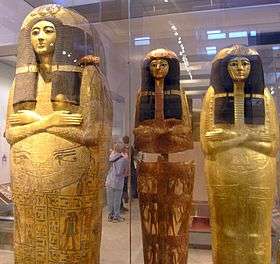Henutmehyt
Henutmehyt was the name of a Theban priestess of ancient Egypt, who lived during the 19th Dynasty, around 1250 BC. Her gilded inner coffin can be seen today at the British Museum in London, England. The excessive use of gold, and the high quality and detail of her coffin indicates that Henutmehyt was a wealthy woman. On the front of the coffin are the figures of Isis and Nephthys, the protectors of the deceased.
| Henutmehyt[1] in hieroglyphs | |||||||||
|---|---|---|---|---|---|---|---|---|---|
Henutmehyt | |||||||||
Priestess from the time of Ramesses II | |||||||||
 | |||||||||
Funerary equipment
Henutmehyt was buried in a set of gilded coffins and a gilded mummy board, which are now in the British Museum.[2] A wooden shabti box which was painted with a scene showing Henutmehyt adoring two of the canopic deities[2] and receiving food and wine from the goddess Nut. There were four shabti boxes in total, containing shabtis made of both wood and pottery.[3]
A funerary papyrus was included in her burial as well. The text is Spell 100 from the Book of the Dead and is written rather unusually in red and white ink. The papyrus was placed over the outer wrappings of the mummy. These types of texts became more common after the New Kingdom.[3]
Magic bricks made of unbaked mud must have been placed in niches in the burial chamber. Henutmehyt's magic bricks were well preserved. They supported amuletic figures: a Djed pillar, the figure of Anubis, a wooden mummiform figure, and a reed. The bricks themselves were inscribed with magic spells.[3]
A wooden box, painted black and containing fowl wrapped in linen and meat possibly from a goat may also belong to the funerary equipment of Henutmehyt. The box contains enough food for a meal.[3]
References
- http://gallery.nen.gov.uk/image68417-.html
- Quirke, Stephen and Spencer, Jeffrey, The British Museum Book of Ancient Egypt, Thames and Hudson, 1992. pp 87, 105 ISBN 0-500-27902-0
- John H. Taylor, Death and the afterlife in ancient Egypt